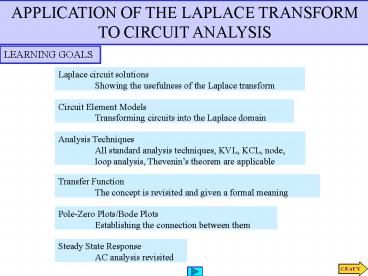APPLICATION OF THE LAPLACE TRANSFORM - PowerPoint PPT Presentation
1 / 47
Title:
APPLICATION OF THE LAPLACE TRANSFORM
Description:
All standard analysis techniques, KVL, KCL, node, ... signal and should attenuate noise. Proposed filter. Below 100k. Well below 100k. above 1k ... – PowerPoint PPT presentation
Number of Views:2521
Avg rating:3.0/5.0
Title: APPLICATION OF THE LAPLACE TRANSFORM
1
APPLICATION OF THE LAPLACE TRANSFORM TO CIRCUIT
ANALYSIS
LEARNING GOALS
Laplace circuit solutions Showing the usefulness
of the Laplace transform
Circuit Element Models Transforming circuits
into the Laplace domain
Analysis Techniques All standard analysis
techniques, KVL, KCL, node, loop analysis,
Thevenins theorem are applicable
Transfer Function The concept is revisited and
given a formal meaning
Pole-Zero Plots/Bode Plots Establishing the
connection between them
Steady State Response AC analysis revisited
2
LAPLACE CIRCUIT SOLUTIONS
We compare a conventional approach to solve
differential equations with a technique using
the Laplace transform
Take Laplace transform of the equation
Initial conditions are automatically included
P a r t i c u l a r
Only algebra is needed
No need to search for particular or
comple- mentary solutions
3
LEARNING BY DOING
Use partial fractions to determine inverse
Initial condition given in implicit form
4
CIRCUIT ELEMENT MODELS
The method used so far follows the steps 1.
Write the differential equation model 2. Use
Laplace transform to convert the model to an
algebraic form
For a more efficient approach 1. Develop
s-domain models for circuit elements 2. Draw the
Laplace equivalent circuit keeping the
interconnections and replacing the elements
by their s-domain models 3. Analyze the Laplace
equivalent circuit. All usual circuit tools are
applicable and all equations are algebraic.
5
Capacitor Model 1
6
Inductor Models
7
Mutual Inductance
8
Determine the model in the s-domain and the
expression for the voltage across the inductor
LEARNING BY DOING
Steady state for tlt0
9
ANALYSIS TECHNIQUES
All the analysis techniques are applicable in the
s-domain
One needs to determine the initial voltage across
the capacitor
10
Write the loop equations in the s-domain
LEARNING EXAMPLE
11
Write the node equations in the s-domain
LEARNING EXAMPLE
12
LEARNING EXAMPLE
Assume all initial conditions are zero
Could have used voltage divider here
13
Loop Analysis
14
Applying current source
Source Superposition
Voltage divider
15
Combine the sources and use current divider
Source Transformation
The resistance is redundant
16
Using Thevenins Theorem
Voltage divider
Only independent sources
17
Using Nortons Theorem
Current division
18
LEARNING EXAMPLE
Selecting the analysis technique
. Three loops, three non-reference nodes . One
voltage source between non-reference nodes -
supernode . One current source. One loop current
known or supermesh . If v_2 is known, v_o can
be obtained with a voltage divider
Transforming the circuit to s-domain
19
Continued ...
-keep dependent source and controlling variable
in the same sub-circuit -Make sub-circuit to be
reduced as simple as possible -Try to leave a
simple voltage divider after reduction to
Thevenin equivalent
20
Continued
Computing the inverse Laplace transform
Analysis in the s-domain has established that the
Laplace transform of the output voltage is
One can also use quadratic factors...
21
LEARNING EXTENSION
Assume zero initial conditions Implicit circuit
transformation to s-domain
KCL at supernode
22
LEARNING EXTENSION
Solve for I2
Determine inverse transform
23
TRANSIENT CIRCUIT ANALYSIS USING LAPLACE TRANSFORM
For the study of transients, especially
transients due to switching, it is important to
determine initial conditions. For this
determination, one relies on the properties 1.
Voltage across capacitors cannot change
discontinuously 2. Current through inductors
cannot change discontinuously
24
Now determine the inverse transform
25
LEARNING EXTENSION
Initial current through inductor
26
LEARNING EXTENSION
Determine initial current through inductor
Use source superposition
27
TRANSFER FUNCTION
H(s) can also be interpreted as the
Laplace transform of the output when the input
is an impulse and all initial conditions are zero
The inverse transform of H(s) is also called the
impulse response of the system
If the impulse response is known then one can
determine the response of the system to ANY other
input
28
LEARNING EXAMPLE
In the Laplace domain, Y(s)H(s)X(s)
29
Impulse response of first and second order systems
First order system
30
LEARNING EXAMPLE
Transform the circuit to the Laplace domain. All
initial conditions set to zero
31
Determine the transfer function, the type of
damping and the unit step response
LEARNING EXAMPLE
Transform the circuit to the Laplace domain. All
initial conditions set to zero
32
Determine the pole-zero plot, the type of damping
and the unit step response
LEARNING EXTENSION
33
Second order networks variation of poles with
damping ratio
34
The Tacoma Narrows Bridge Revisited
LEARNING EXAMPLE
Previously the event was modeled as a resonance
problem. More detailed studies show that a model
with a wind-dependent damping ratio provides a
better explanation
Torsional Resonance Model
Problem Develop a circuit that models this event
35
Simulation building blocks
Simulation using dependent sources
36
Simulation results
37
POLE-ZERO PLOT/BODE PLOT CONNECTION
They show a cross section of G(s)
If the poles get closer to imaginary axis the
peaks and valleys are more pronounced
38
Cross section
39
STEADY STATE RESPONSE
Laplace uses positive time functions. Even for
sinusoids the response contains transitory terms
If interested in the steady state response only,
then dont determine residues associated with
transient terms
40
Determine the steady state response
LEARNING EXAMPLE
Transform the circuit to the Laplace
domain. Assume all initial conditions are zero
41
LEARNING EXTENSION
Transform circuit to Laplace domain. Assume all
initial conditions are zero
42
LEARNING BY APPLICATION
43
Filtering noise in a data transmission line
LEARNING BY DESIGN
Noise source is 100kHz
Data bits at 1000bps
SOLUTION Insert a second order low-pass filter
in the path. Should not affect data signal and
should attenuate noise
44
REDESIGN!
45
(No Transcript)
46
THIS FILTER EXHIBITS TOO MUCH OSCILLATION TO
PULSE INPUTS.
LEARNING EXAMPLE
Must be made critically damped
Decrease resistance by a factor of four
47
DESIGN EXAMPLE
A 10kHz Wein Bridge Oscillator
Select C100nF then R1.59k































